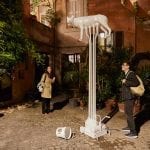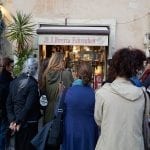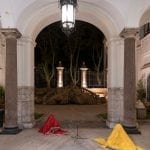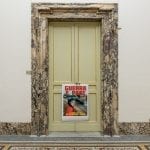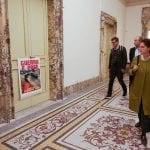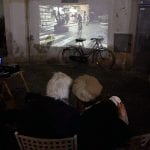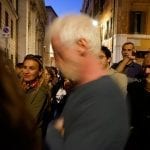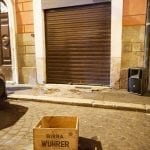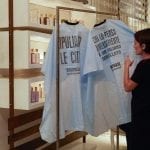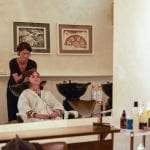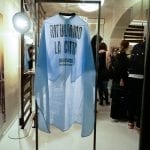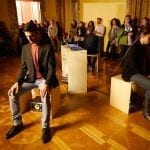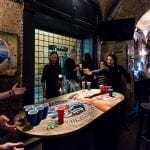Mirabilia Urbis 2019
Contemporary Art Exhibition
7–13 October 2019
Inauguration: Monday, 7 October, 6–12 pm
Where: Historical Centre of Rome (various locations)

The exhibition project, planned by Carlo Caloro and produced by artQ13, was curated by Giuliana Benassi with the support of the Assessorato alle Politiche Culturali e Beni Culturali, in the person of Cinzia Guido of the Municipio I Centro Roma Capitale. It involved around twenty Italian and international artists: Alterazioni Video, Josè Angelino, Elena Bellantoni, Tomaso Binga, Carlo Caloro, Federica Di Carlo, Stanislao Di Giugno, Rä di Martino, Flavio Favelli, Grossi Maglioni, Hortensia Mi Kafchin, Britta Lenk, Via Lewandowsky, Girolamo Marri, Diego Miguel Mirabella, Jonathan Monk, Matteo Nasini, Lulù Nuti, Leonardo Petrucci, Giuseppe Pietroniro, Calixto Ramirez, Julian Rosefeldt, Corrado Sassi, Alice Schivardi, Lamberto Teotino
The exhibition
The artists and their work
The performances of 7 October 2019
The book
artq13
Press review
The exhibition
Mirabilia Urbis is an itinerant exhibition, a path to follow and to walk along, with stops situated around the area of Campo de’ Fiori and the labyrinth of streets and alleys that branch out from one of the most characteristic squares of Rome. The title is borrowed from the old tourist guides that originated in the Middle Ages, the most widely used GPS of the period that constituted an indispensable instrument for navigating the dark streets and reaching spiritual destinations and secular monuments. In these books, much attention was paid to antiquities, while contemporary sites were not considered.
In the case of our exhibition, the exact opposite is practised, but the rhythm suggested by walking or travelling by carriage is retained and reshaped as an invitation to walk on foot or to board the rickshaw provided for the occasion. The visitors’ indispensable travel companion: the guide (book-catalogue) is meant to be a reference tool, a compass, and a magnifying glass for some of the aspects regarding the locations and the works of art exhibited. Loyal travel companion, this guide forms an integral part of the exhibition. The map with its various focus points is the most practical instrument for moving around and following the route, while the pages containing information on the places hosting the artists’ work represent the views of the business owners and locals of the area, their voice narrating the here and elsewhere. An informative page, dedicated to the artists and their work, introduces the visitor to the individual research projects and the reasons concerning the choice of the artworks.
The visitor should not expect a traditional tourist tour, but a real exploration of life in this particular area. An itinerary characterised by contradictions, coherent moments, stops, and accelerations. If the art presented here is contemporary, then so is the guide. The aim of the exhibition is to analyze and register, through artistic practices, the transformations that led to a mutation of social, economic, administrative, political, cultural, and artistic structures, on which stand the founding values of contemporary reality. For this reason, the sites chosen for the exhibition are those that have managed to resist the wave of commercial transformation within the area, such as the cinema, the bookshop and the luthier, together with new realities that are fruit of recent political developments, such as the pub in the piazza, or the cannabis shop. Other stops, however, are historical sites that are part of the public space, chosen with the aim to reactivate their cultural life.
If the locations chosen are in conflict with each other, and the combinations are schizophrenic, they reflect the conflictual soul of a narration made up of melodies and cacophonies, soft and off-key notes, starry nights pervaded by the sound of the mandolin, and alleys, dark with the rustling of dirty money. The works shown in the exhibition confront themselves with the conflictual rhythm of this geography, with its consistency and frequency, in order to interpret its contrasts, surfaces, interruptions, to silence the idyllic or to exacerbate utopias and dystopias. Autobiographical testimonies, interviews, anecdotes, and historical information: in Mirabilia Urbis all flows freely together, without any apparent rule. The playground is, in fact, a complex social space, which, at the limit of the impossible, seems to be able, despite all, to govern itself and to maintain its equilibrium, albeit in a precarious and continuously changing way. An ecosystem that welcomes the new and looks back longingly at the old, but which continues to exist while continually changing its face, slowly changing its identity while trying at the same time not to go beyond its limit. A system that aims to protect the biodiversity necessary for life, with all its contradictions, acrobatics, and little magic tricks. An eternal conflict that wants to transform itself, on these pages just as in the piazza and the streets, into a generator of energy. A conflict, therefore, that – in dialectical terms – sounds like a new resource, a catalysing engine.
The artists and their work
The incipit of the exhibition itinerary is suggested by the videos exhibited at Cinema Farnese: Deep Gold by Julian Rosefeldt and America è la terra by Tomaso Binga. Works diversely representing two surreal planets, one on extreme feminism staged between the streets and places of a surreal reality, the other on the subversion of the sense of discovery, playing with the America of Columbus in a delirium of words and images. In the foyer, the works by Stanislao Di Giugno explore the world of virtual relationships, social media, and the web – using details of Instagram comments as pictorial occasions. Together with photographic prints by Lamberto Teotino, the historical cinema becomes a kaleidoscope of future glimpses that are, however, set in the past. The exhibition as a whole plays with this coming and going of time, where present and past seem to be in conflict with each other, where myth becomes the perspective of the present. The sculptural work Naturam expellas furca tamen usque recurret / You may crush nature with a pitchfork, but she will still always return, a collaboration between Carlo Caloro and Via Lewandowsky, fuses the Capitoline wolf with the machine in a nature-technology vision, presented as a seductive alternative destined to generate future catastrophes, such as a famine, as foreshadowed by the bucket of spilled milk. On the trail of the relationship between man and machine, Hortensia Mi Kafchin presents several drawings executed in a state of altered conscience in the cannabis store, ironising the concept of visions of future apocalyptic scenarios.
The exhibition as a whole is determined by the criterion of correspondence between the place and the research of the artists, who often came by in person to experiment on site, or to develop an idea inspired by the respective site. Just as the work by Josè Angelino – a project developed together with the violin-maker Michel from via di Montoro, in order to give voice to the cords of the virgin instruments through a sound installation. Or the work by Matteo Nasini at Libreria Fahrenheit 451, Musica per piccole librerie, which offers a musical interpretation of the books and their arrangement on shelves by flooding the space, already filled with paper, with sound.
Some artists had the occasion to work in places they were already familiar with, as in the case of Rä di Martino with her work Tra Amburgo e Haiti, inspired by some historical manifestos found in the shop Hollywood where the adolescent artist used to go after lessons at the nearby liceo Virgilio. Lulù Nuti, on the other hand, took part in the exhibition on the street in front of the Bar Farnese, spreading out a carpet on the ground: the ‘pedestal‘ of a mobile sculpture meant to reflect on the perception of time starting from personal childhood memories at the bar. Flavio Favelli, whose research starts from autobiographical topoi, participated in the store windows of the travel agency in vicolo del Gallo with an installation consisting of a collage of publicity images taken from playboy magazines from the 80s, thereby concealing the windows of the travel agency that was founded in that period.
Space-time frictions, conflicts and interferences connect these works and dictate the rhythm of the itinerary. Upon entering Palazzo Falconieri – seat of the Hungarian Academy – visitors will encounter the installation by Grossi Maglioni, Occupazioni: the split child, one of several episodes of the project Occupazioni, which narrates the story of a young boy and his growing up. On the first floor, the work by Giuseppe Pietroniro traces the conflictual dance between the real space and the space on stage, while the video work Guerra e Pace by Alterazioni Video plays with the phenomenon of fake news in order to reflect on the stringent contrast between reality and fiction in our society, without omitting political references. Walking along via Giulia, at the height of the Criminological Museum, the work by Corrado Sassi L’enigma anello Pino Pelosi conflates with the suspended image of the ring in the mysterious event of Pier Paolo Pasolini’s murder. The words uttered by the alleged murderer evoke the enigma around the object found at the crime scene. Not far away, in vicolo della Moretta, the performative installation Art Lover – L’amore immobiliare by Sassi plays with the audience by presenting a wall sculpture equipped with a digital caption: while the title remains the same, the name of the artist changes continuously.
The traditional workshops have nearly all disappeared. One of the exceptions being the Renaissance and Baroque picture frame shop in via Monserrato where Diego Miguel Mirabella avoids the pictorial discourse – the ’ethics‘ of his poetics – in order to play with a spherical sculpture-object presented with great pomp on a wooden pedestal that echoes the context of the workshop. On the same street, Galleria Colli Independent hosts the works by two artists – Britta Lenk and Federica Di Carlo. This location of the route is the only exhibition space by nature. The artists have decided to use it in metaphorical terms: On the ground floor, Lenk presents a sculptural installation that plays with the relationship between reflective material and light, transforming the space into a circle of continuous possible sunrises and sunsets of perception. In the basement, Di Carlo accompanies the visitor to a submarine environment permeated with sound, where the call of the sea coincides with the reawakening of conscience in the presence of a nature that is, by now, in conflict with man. Another underground space is the crypta in Santa Lucia al Gonfalone pervaded with the work by Calixto Ramirez, Concert for 64 hands, a tribute to music and dance where rhythm is measured by hand, and time coincides with gestures within space.
The performances on the itinerary allow the visitor to bridge the time of the walk through ephemeral events: the performance by Girolamo Marri at Wala with his subtle Disquisizione sul confine; the sound performance by Carlo Caloro based on the neurofeedback of the dynamics of intersubjective communication in one of the rooms of the Hungarian Academy; or the bicycle tour by Alice Schiavardi based on the itinerary undertaken by the partisan fighter Mario Fiorentini leading to the historic seat of the PCI. Other appointments are conceived as occasions where the ‘pilgrim‘ can pause and participate. Among these is the performance Brainwash by Elena Bellantoni at Head Space. A metaphorical action that transforms the hairdresser’s massage into a reflection on the brainwashing provoked by contemporary politics. The playful entertainment Leon Hard provided by Leonardo Petrucci playing with the carefree habits exhibited at the pub Drunken Ship, and the coffee at Bar Perù served with punctured spoons created by Carlo Caloro, a work that recalls the famous operation Blue Moon in the 70s that aimed at obstructing the use of heroin in bars.
Some works, therefore, recall the history of the 60s onwards, reflecting on the political and social transformations. Campo de’ Fiori in particular was the site of historical demonstrations, a significant crossroads of ideological and political movements, also because of its closeness to the historic seat of the PCI. The ending of the itinerant exhibition forms the work by Jonathan Monk, Che fare? – on show inside a room of a B&B in via del Pellegrino – that derides and desecrates the conflict between past and present, subtly playing with the question that seeps through the exhibition as a whole. Reproducing the well-known work by Mario Merz, the English artist imagines provoking the visitors with the question that is by now removed from its historic allusion, making them formulate two different answers: to leave the room to visit the monuments (mirabilia), or to start a revolution?
The performances of 7 October 2019
Girolamo Marri, Disquisizione sul confine
The performances by Girolamo Marri are conferences without a start, a frenzy of group meditation, silent interviews without questions or answers, lessons without a topic, talking as if improvising with a musical instrument, cognitive maps, and tests to be corrected without ever understanding, ephemeral installations. The attempt by Marri to represent the idea of a fluid and highly unforeseeable existence. His language is always tied to an action and, even when that action focuses on the creation of an installation or graphic work, it originates from an immediate gesture freely refracted in the surrounding space and the spectator.
Elena Bellantoni, Brainwash
Brainwash is a performative project that starts from the concept of ‘brainwashing‘, understood as an action of strong psychological conditioning aimed at eradicating one’s free will and personality in order to radically change their ideas and convictions. Starting from this concept, Elena Bellantoni stages a performance in which the participants listen to a text via headphones while receiving a massage by the artist instead of the usual hair washing at the hairdresser. The text, conceptual and political, enters in conflict with the seductive nature of the massage. In the phase of ‘reflection‘, the artist places the person in front of a mirror and asks a clear question in order to seal the action with an answer conditioned by the action itself.
Carlo Caloro, Binding or not-Binding Commitments
In the performance Binding or not-Binding Commitments by Carlo Caloro, the technique of neurofeedback is used, a non-invasive technique used at neuro-cognitive level to treat certain clinical situations, as in the therapy of pathologies of ADHD or migraines. Normally, in order to register an individual completely, it would be necessary to apply four electrodes on one individual’s scalp. In the performance, by contrast, every singer is supplied with one electrode with the electroencephalographical lines being simultaneously registered and monitored by the same amplificator. If the attention span of the individual singers and the level of empathy is elevated, their voices can be heard from four speakers in one single harmonious song. The work presents itself as a dispositive that trains the cooperation and resolution of conflicts. It offers expression for the contemporary need to construct binding We-communities, in contrast with the spread of individualistic and narcissistic behaviour of the masses, non-binding I-communities.
Leonardo Petrucci, Leon Hard
The site-specific intervention by Leonardo Petrucci at the pub is of a dual nature: performance and installation. In fact, the artist wanted to interpret the atmosphere of the place characterized by American tourists dedicated to drinking alcohol. One of the most well known features is the American game beer pong, the real protagonist of many Roman nights. Substituting the beer with an alcoholic cocktail called Leon Hard, invented by the artist for the occasion, the game is transformed into a performative action involving groups of people. This performative gesture is accompanied by vinyl disc covers from the series Art & Metal, elaborated by applying original titles from the metal rock scene to historical art works, creating a short visual circuit. The irony that characterizes the collection of LPs is paralleled by the irony of the game and emphasised by the rhythm of the background music, selected among the tracks of the albums included in the performance.
Alice Schivardi, La vita è una ruota
The work La vita è una ruota was born from a conversation between the artist and Mario Fiorentini, a partisan (fighter) born in 1918, who was active in numerous actions on Roman territory. In particular, the narration of the attack at the prison Regina Coeli led Alice Schivardi to conceive a performance tour in the city, emulating the tour with the vehicle used by the partisan: a bicycle. On 26th December 1943, Fiorentini launched an explosive package at the entrance of Regina Coeli from his bicycle while 28 German soldiers were changing posts. Thanks to the agility of his bicycle, he managed to escape the fire. Immediately after, the German command issued an order that prohibited the use of the bicycle in the entire city. During these years, the champion road cyclist Gino Bartali, too, pretended to practise in order to deliver packages to the partisans. More in general, in the course of the resistance in Italy, the bicycle was the partisans’ most important means of transporting documents in order to coordinate the brigades. Starting from these reports, the artist constructed the performance with the intention to trace Fiorentini’s antifascist action on his bicycle, retracing as faithfully as possible the tour he took on 26th December. The action, filmed with cameras scattered at various stages of the itinerary, has given life to a video with its own autonomy shown at the day of the opening, when the artist was cycling to the exhibition place, on the site of the historic seat of PCI, to finally meet Fiorentini.
The book

The exhibition was first of all an experience offered to the visitor that, as in a sort of a treasure hunt, gave the opportunity to explore the area with a map in hand to find the works scattered in various places. The adventure was not only for those on foot, but rickshaws and shuttle buses allowed the contemporary pilgrim to accelerate the distances between the various exhibition spots and the performances, the latter during the evening of inauguration. Today, apart from the photos taken during the vernissage, remains the book edited by Viaindustriae, conceived as a guide of the exhibition tour, a handbook for the journey and catalogue of the works. The book is rich with texts and images, historical information sheets that describe the places with the ingenuity of the classic tourist guides, and interviews directly held with the people from the area, thus enriching the playful itinerary with anecdotes and dialectic shades. The locations have also been described by the voice of their owners. All of this with the intention to get to the works of art, which were either presented as site-specific interventions or chosen for their affinity to specific locations.
Further reading:
Giuliana Benassi, “Che meraviglia Roma! L’arte che ridisegna gli itinerari”, in: Mirabilia Urbis, exhibition catalogue, VIAINDUSTRIAE publishing, Foligno 2019, pp. 16–31 [PDF-Download, 1 MB]
artq13
Since 2014, the independent project artq13 has been operating both in a fixed location in the area Aurelia in Rome, where it realizes exhibition and art projects, and excursions to locations chosen by the founders Carlo Caloro and Britta Lenk. In addition to its main focus on artistic research, artQ13 has also been experimenting with alternative ways of financing its projects ever since its foundation. artQ13 approaches the development of its artistic projects with attention to the resolution of conflicts originating from the management of cultural spaces. The normative legislative asset that regulates entities for cultural promotion does not recognize the concept of an independent artistic space. This would require a cultural association, which is, however, inappropriate for the running of an exhibition space, due to bureaucratic limitations.
Press Review
– Artribune, 30.9.2019: Mirabilia Urbis: una mostra di arte contemporanea dislocata lungo le antiche vie di Roma
– Roma Today, 9.10.2019: Mirabilia Urbis, mostra d’arte contemporanea “itinerante” per le vie di Roma
– La Repubblica, 10.10.2019: Roma, “Mirabilia Urbis”: scultura, fotografia e video arte intorno a Campo de’ Fiori
Project: Tatjana Bartsch, Giuliana Benassi, Carlo Caloro, Johannes Röll
Texts: Giuliana Benassi, Carlo Caloro
Translations: Charlotte Huber
Photographs: Tatjana Bartsch, Giuliana Benassi, Giorgio Benny, Simon D’Exéa, Enrico Fontolan, Sebastiano Luciano, Johannes Röll
Realization: Tatjana Bartsch, Madelaine Merino
15.11.2019

















